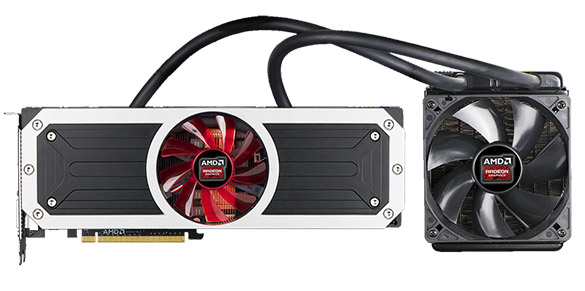AMD Radeon R9 295X2 Review: Hawaii x 2
Introduction and Related Information
For the past few weeks, AMD has been strategically dropping hints about the product we’ll be showing you here today—the ultra, powerful Radeon R9 295X2. If you’ve spent any time on our home page recently, or on social media sites like Facebook or Twitter, you may have seen the “two is better than one” tag-line bandied about on a couple of occasions. AMD was initially coy about whether or not the company was involved in the campaign, but it eventually became clear that not only was AMD involved, but that it was teasing a new flagship, dual-GPU powered graphics card. How did we (and virtually everyone else) know? It’s not terribly hard to put two-and-two together when a couple of containers of chips and a bottle of Hawaiian volcanic water arrive straight from AMD’s PR agency. And then you’ve got AMD posting pictures like this one on social media…but I digress.
Going back all the way to the Rage Fury MAXX, ATI/AMD has had a long history of releasing dual-GPU powered graphics cards. During the previous generation, AMD so much as said the Radeon HD 7990 was coming well before the single-GPU powered Radeon HD 7970 even launched, but a number of things delayed the arrival of the 7990, and towards the end of its development cycle we got the sense AMD was sick of answering questions about it and regretted unveiling its plan so early. This time around, there wasn’t so much as a peep (at least officially) out of AMD about a dual Hawaii GPU-based graphics card. Some folks--including yours truly--even wondered if AMD would attempt a dual Hawaii GPU-based card after seeing how much power a single Radeon R9 290X consumed, not to mention the difficulty in routing traces for dual 512-bit memory interface.
But, they did, and AMD is ready to take the wraps off of what is undoubtedly the most powerful graphics card the company as ever produced. The Radeon R9 295X2’s full list of features and specification are listed below, along with some reference data from the R9 290X and R9 290. As you’ll see, this thing is an absolute beast.

The Radeon R9 295X2 Dual-GPU Powered Graphics Card
|
| Radeon R9 295X2 | Radeon R9 290X | Radeon R9 290 | |
| Process | 28nm | 28nm | 28nm |
| Stream Processors | 5632 | 2816 | 2560 |
| Engine Clock | Up to 1018 MHz | Up to 1 GHz | Up to 947 MHz |
| Compute Performance | 11.5 TFLOPs | 5.6 TFLOPs | 4.9 TFLOPs |
| Texture Units | 352 | 176 | 160 |
| Texture Fill-Rate | Up to 358.3 GT/s | Up to 176.0 GT/s | Up to 151.5 GT/s |
| ROPs | 128 | 64 | 64 |
| Pixel Fill-Rate | Up to 130.3 GP/s | Up to 64 GP/s | Up to 60.6 GP/s |
| Z/Stencil | 512 | 256 | 256 |
| Memory Configuration | 8GB GDDR5 | 4GB GDDR5 | 4GB GDDR5 |
| Memory Interface | Dual 512-bit | 512-bit | 512-bit |
| Memory Speed | 5.0 Gbps | 5.0 Gbps | 5.0 Gbps |
| Power Connectors | 2 x 8-pin | 1 x 6-pin, 1 x 8-pin | 1 x 6-pin, 1 x 8-pin |
| Typical Board Power | 500W | 250W | 250W |
| PCI-E Standard | PCI-E 3.0 | PCI-E 3.0 | PCI-E 3.0 |
| DirectX Support | DirectX 11.2 | DirectX 11.2 | DirectX 11.2 |
| Mantle Support | Yes | Yes | Yes |
The Radeon R9 295X2’s specifications tell a large part of the story. As you can see in the chart above, the card is essentially two Radeon R9 290Xes crammed onto a single PCB, though the 295X2’s peak GPU frequency is actually a bit higher (1018MHz vs. 1000MHz). If you want to nit-pick, technically, the Radeon R9 295X2 is MORE powerful than a pair of Radeon R9 290X cards running in CrossFire, thanks to its higher GPU peak clock.

The Radeon R9 295X2 -- Liquid Cooled, Right Out Of The Box
Because the Radeon R9 295X2 features the very same Hawaii GPU that’s at the heart of the Radeon R9 290X and R9 290, we won’t be covering many of the deep technical details again here; in this piece, we’re going to focus on the R9 295X2 itself. We would, however, recommend checking out a couple of previous articles if you’d a refresher on what AMD put into Hawaii:
- AMD Radeon R9 290X Review: Welcome To Hawaii
- AMD Radeon R9 290 Review: Hawaii Just Got Cheaper
- AMD and DICE Bring Low-Level, High-Performance Graphics API To PCs With "Mantle"
- AMD Radeon R7 260X, R9 270X, and R9 280X Tested
- AMD Mantle vs. DirectX Benchmarks with Battlefield 4 and Star Swarm
In our coverage of the Radeon R9 290X, we discuss many of the Hawaii GPUs main features, like its new dongle-less CrossFire DMA engine, TrueAudio Technology, new PowerTune features, Mantle, and its flexible display output options. Of course, we also cover performance—like we did in the Radeon R9 290 piece as well. We also discuss the other members in the Radeon R-series of graphics cards in the “AMD Radeon R7 260X, R9 270X, and R9 280X Tested” piece, and show what kind of performance impact is available with Mantle in our Battlefield 4 and Star Swarm benchmarks.
We’ve got a full set of new numbers here, but if you want to see what kind of technology is incorporated into AMD’s current flagship GPU, those articles should do the trick.






